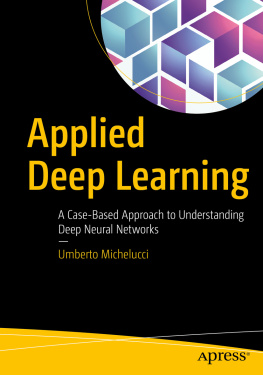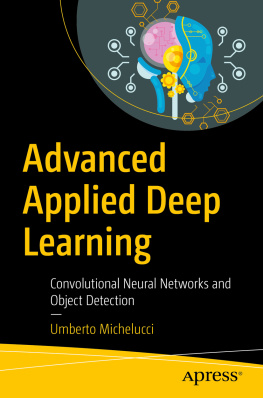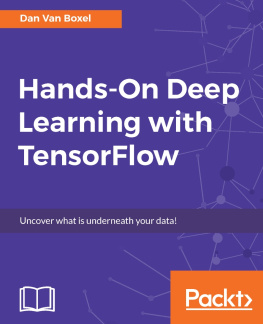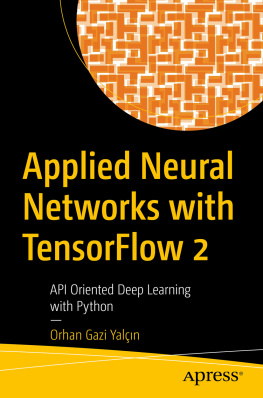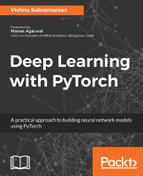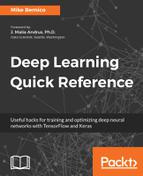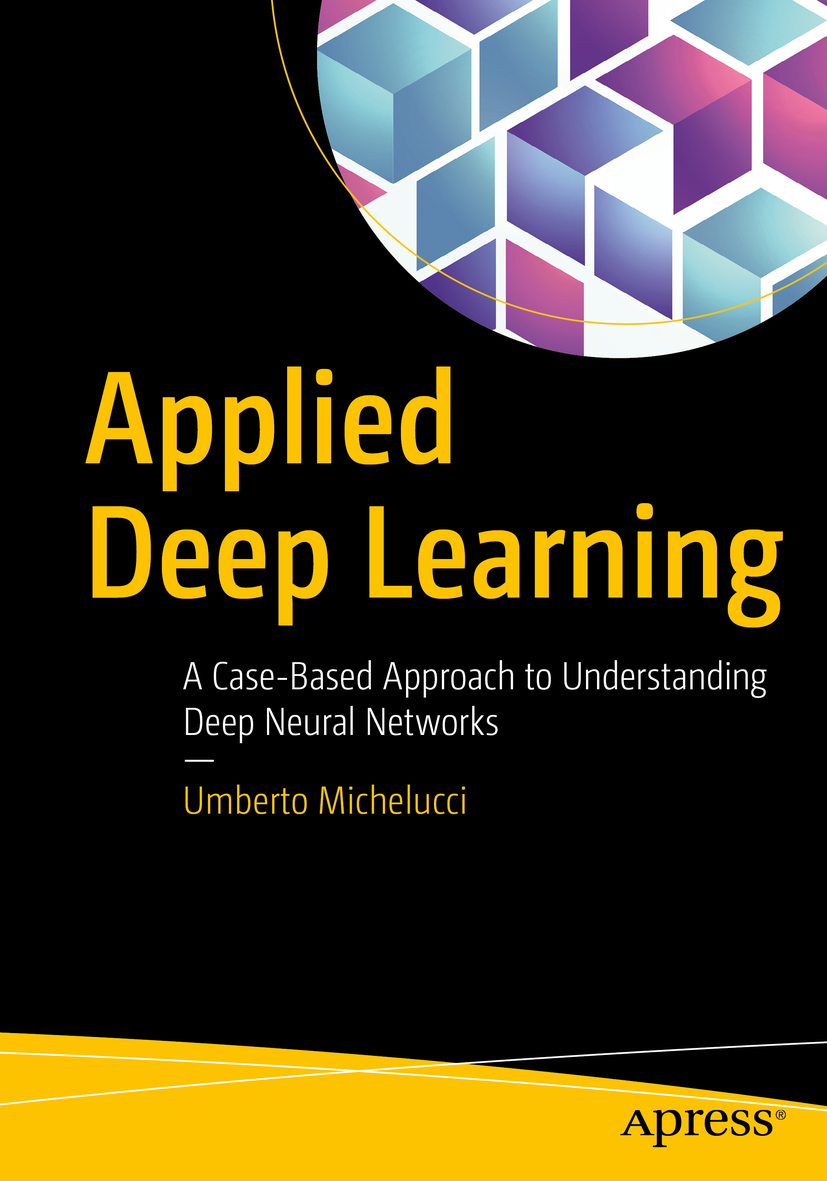Umberto Michelucci
Applied Deep Learning A Case-Based Approach to Understanding Deep Neural Networks
Umberto Michelucci
toelt.ai, Dbendorf, Switzerland
Any source code or other supplementary material referenced by the author in this book is available to readers on GitHub via the books product page, located at www.apress.com/9781484237892 . For more detailed information, please visit www.apress.com/source-code .
ISBN 978-1-4842-3789-2 e-ISBN 978-1-4842-3790-8
https://doi.org/10.1007/978-1-4842-3790-8
Library of Congress Control Number: 2018955206
Umberto Michelucci 2018
This work is subject to copyright. All rights are reserved by the Publisher, whether the whole or part of the material is concerned, specifically the rights of translation, reprinting, reuse of illustrations, recitation, broadcasting, reproduction on microfilms or in any other physical way, and transmission or information storage and retrieval, electronic adaptation, computer software, or by similar or dissimilar methodology now known or hereafter developed.
Trademarked names, logos, and images may appear in this book. Rather than use a trademark symbol with every occurrence of a trademarked name, logo, or image, we use the names, logos, and images only in an editorial fashion and to the benefit of the trademark owner, with no intention of infringement of the trademark. The use in this publication of trade names, trademarks, service marks, and similar terms, even if they are not identified as such, is not to be taken as an expression of opinion as to whether or not they are subject to proprietary rights.
While the advice and information in this book are believed to be true and accurate at the date of publication, neither the author nor the editors nor the publisher can accept any legal responsibility for any errors or omissions that may be made. The publisher makes no warranty, express or implied, with respect to the material contained herein.
Distributed to the book trade worldwide by Springer Science+Business Media New York, 233 Spring Street, 6th Floor, New York, NY 10013. Phone 1-800-SPRINGER, fax (201) 348-4505, e-mail orders ny@springer-sbm.com, or visit www.springeronline.com. Apress Media, LLC is a California LLC and the sole member (owner) is Springer Science+Business Media Finance Inc (SSBM Finance Inc). SSBM Finance Inc is a Delaware corporation.
I dedicate this book to my daughter, Caterina, and my wife, Francesca. Thank you for the inspiration, the motivation, and the happiness you bring to my life every day. Without you, this would not have been possible.
Introduction
Why another book on applied deep learning? That is the question I asked myself before starting to write this volume. After all, do a Google search on the subject, and you will be overwhelmed by the huge number of results. The problem I encountered, however, is that I found material only to implement very basic models on very simple datasets. Over and over again, the same problems, the same hints, and the same tips are offered. If you want to learn how to classify the Modified National Institute of Standards and Technology (MNIST) dataset of ten handwritten digits, you are in luck. (Almost everyone with a blog has done that, mostly copying the code available on the TensorFlow web site). Searching for something else to learn how logistic regression works? Not so easy. How to prepare a dataset to perform an interesting binary classification? Even more difficult. I felt there was a need to fill this gap. I spent hours trying to debug models for reasons as silly as having the labels wrong. For example, instead of 0 and 1, I had 1 and 2, but no blog warned me about that. It is important to conduct a proper metric analysis when developing models, but no one teaches you how (at least not in material that is easily accessible). This gap needed to be filled. I find that covering more complex examples, from data preparation to error analysis, is a very efficient and fun way to learn the right techniques. In this book, I have always tried to cover complete and complex examples to explain concepts that are not so easy to understand in any other way. It is not possible to understand why it is important to choose the right learning rate if you dont see what can happen when you select the wrong value. Therefore, I always explain concepts with real examples and with fully fledged and tested Python code that you can reuse. Note that the goal of this book is not to make you a Python or TensorFlow expert, or someone who can develop new complex algorithms. Python and TensorFlow are simply tools that are very well suited to develop models and get results quickly. Therefore, I use them. I could have used other tools, but those are the ones most often used by practitioners, so it makes sense to choose them. If you must learn, better that it be something you can use in your own projects and for your own career.
The goal of this book is to let you see more advanced material with new eyes. I cover the mathematical background as much as I can, because I feel that it is necessary for a complete understanding of the difficulties and reasoning behind many concepts. You cannot comprehend why a large learning rate will make your model (strictly speaking, the cost function) diverge, if you dont know how the gradient descent algorithm works mathematically. In all real-life projects, you will not have to calculate partial derivatives or complex sums, but you will have to understand them to be able to evaluate what can work and what cannot (and especially why). Appreciating why a library such as TensorFlow makes your life easier is only possible if you try to develop a trivial model with one neuron from scratch. It is a very instructive thing to do, and I will show you how in Chapter . Once you have done it once, you will remember it forever, and you will really appreciate libraries such as TensorFlow.
I suggest that you really try to understand the mathematical underpinnings (although this is not strictly necessary to profit from the book), because they will allow you to fully understand many concepts that otherwise cannot be understood completely. Machine learning is a very complicated subject, and it is utopic to think that it is possible to understand it thoroughly without a good grasp of mathematics or Python. In each chapter, I highlight important tips to develop things efficiently in Python. There is no statement in this book that is not backed up by concrete examples and reproducible code. I will not discuss anything without offering related real-life examples. In this way, everything will make sense immediately, and you will remember it.
Take the time to study the code that you find in this book and try it for yourself. As every good teacher knows, learning works best when students try to resolve problems themselves. Try, make mistakes, and learn. Read a chapter, type in the code, and try to modify it. For example, in Chapter , I will show you how to perform binary classification recognition between two handwritten digits: 1 and 2. Take the code and try two different digits. Play with the code and have fun.
By design, the code that you will find in this book is written as simply as possible. It is not optimized, and I know that it is possible to write much better-performing code, but by doing so, I would have sacrificed clarity and readability. The goal of this book is not to teach you to write highly optimized Python code; it is to let you understand the fundamental concepts of the algorithms and their limitations and give you a solid basis with which to continue your learning in this field. Regardless, I will, of course, point out important Python implementation details, such as, for example, how you should avoid standard Python loops as much as possible.

